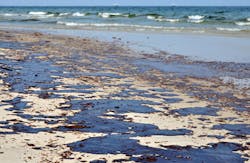Sheens of oil in the Gulf of Mexico near the site of 2010's Deepwater Horizon oil spill, repeatedly occurring since September 2012, have puzzled scientists and have caused fears that oil may once again be leaking from the sealed well. Results from a chemical analysis of the sheens, however, show that they are the result of oil pockets trapped within the remains of the sunken Deepwater Horizon rig, the National Science Foundation (NSF), which funded the research, announced this week.
The oil sheens were first detected by BP employees in September last year and were reported to the U.S. Coast Guard. Their discovery sparked fears that the infamous Macondo well, capped in July 2010, could be spewing oil once again. Samples were taken immediately and a thorough analysis was conducted. The oil samples were compared to similar oil sheens from a number of sources, including pieces of wreckage taken after the Deepwater Horizon drilling rig exploded and sank in April 2010.
Researchers at the UC Santa Barbara and Woods Hole Oceanographic Institution (WHOI) revealed that the oil source was not the Macondo well and the oil was certainly not coming from the natural oil seeps typical for the Gulf of Mexico. The study, published this week in the journal Environmental Science and Technology, concluded that there was no new leak and the oil was coming from isolated tanks and pockets of the rig wreckage.
According to David Valentine, a geochemist at the University of California at Santa Barbara, the source of the sheens seems to be a slow leak from the wreckage of the rig, rather than another discharge from a deep oil reservoir. The fact that there is still oil discharge from the wreckage of the Deepwater Horizon rig is not good news, but at least the amount of leakage is limited to the pockets of oil trapped within the wreckage of the rig, he commented.
RELATED: Deepwater Horizon rig operator fined $1.4 billion
Thanks to a technique developed by WHOI researcher Chris Reddy, the team of scientists found that the oil samples from the sheens reported last year were exact matches to those taken from the rig wreckage. The samples contained the same amounts of olefins, which are not found in crude oil, suggesting that the sheens could not originate from the Macondo well or any other natural oil seep in the Gulf, the NSF stated.
When the Deepwater Horizon sank, there were tanks on it containing hundreds of barrels filled with a mixture of drilling mud and oil. Researchers believe that these tanks could be leaking as a result of gradual corrosion caused by seawater, the statement pointed out.
The Deepwater Horizon oil spill was the biggest in U.S. history, releasing about 205 million gallons of oil. The area of the Gulf on Mexico near the spill has been trying to recover from the adverse effects of the oil since then, environmentalists said.
